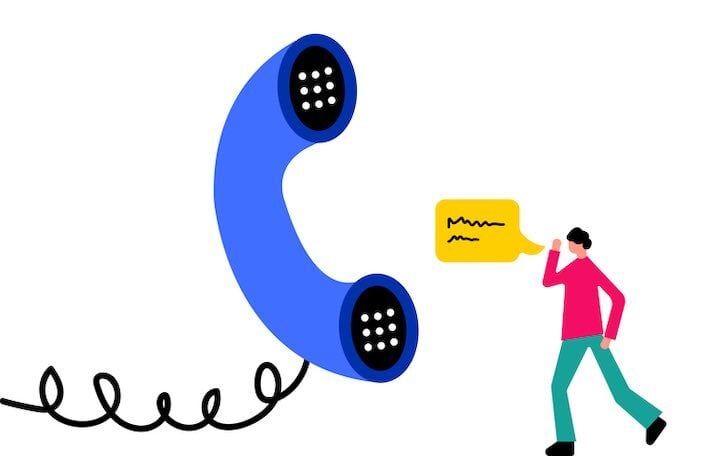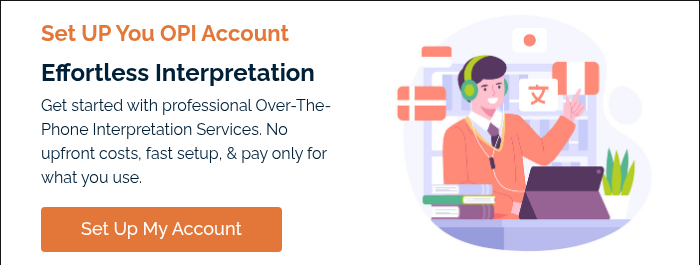How to Train Your Team to Work Effectively With OPI Providers

If your business has international customers, stakeholders, partners or any type of operations, it’s no longer unusual to pick up the phone and find yourself speaking to someone who doesn’t share your primary language.
For businesses, healthcare providers, government agencies, and customer support teams, this can make communication challenging, but not impossible. Thanks to Over-the-Phone Interpretation (OPI) services, language barriers can be bridged quickly and effectively.
As a Language Service Provider (LSP), we help a lot of clients use OPI effectively. It’s not difficult, but here’s the key: using OPI successfully isn’t just about having access to the service, it’s about making sure your team knows how to work with interpreters effectively.
Without training, conversations can feel awkward, clunky, or even confusing. With the right training, though, your team can make these interactions seamless, professional, and comfortable for everyone involved.
Let’s walk through some practical, easy tips you can use to train your team.
Start With the Basics: What OPI Is (and Isn’t)
Before your team can use phone interpretation services effectively, they need to know what they’re working with. OPI is not just “translation over the phone.”
It’s a real-time, three-way conversation involving:
- The staff member.
- The non-English-speaking client.
- A professional interpreter.
Your team should understand that interpreters are trained professionals. They are not there to “chat” or to give advice, they’re there to relay information accurately between two parties.
This means interpreters stick to the words spoken, and they don’t soften, skip, or alter meaning. Helping your team understand this upfront avoids misunderstandings later.
Teach the Golden Rule: Speak to the Client, Not the Interpreter
One of the most common mistakes people make is directing their attention to the interpreter rather than the person they’re actually speaking with. For example, saying: “Tell her I need her date of birth.”
Instead, teach your team to address the client directly: “What is your date of birth?”
The interpreter will take care of the rest. This keeps the conversation natural and respectful, and it helps build trust with the client.
Pace Matters: Slow Down, But Don’t Dumb Down
Remind your team that they don’t need to speak loudly or “simplify” their language unnaturally. Instead, what helps most is pacing. Interpreters need space to accurately render what’s being said.
That means:
- Speaking in short, clear sentences.
- Pausing after a thought to let the interpreter catch up.
- Avoiding long-winded explanations before giving the interpreter a chance to interpret.
This doesn’t mean speaking robotically, it just means breaking ideas into digestible pieces.
Confidentiality and Professionalism Still Apply
Some staff may feel a little uncomfortable knowing that a third party is listening in. That’s natural. It’s important to train your team that professional interpreters are bound by strict confidentiality standards. What is said on the line stays on the line.
Reassure your team (and your clients) that interpreters are impartial, professional, and trained to handle sensitive topics respectfully. This builds confidence in the process.
Practice Scenarios With Roleplay
One of the best training tools is simple roleplay. Create mock calls where one team member plays the role of the non-English-speaking client, another uses the interpreter service, and someone else observes.
This allows your team to:
- Practice waiting for interpretation.
- Get comfortable speaking directly to the client.
- Experience how the rhythm of an interpreted call feels.
A short round of roleplay goes a long way in helping employees feel less nervous when the real calls come in.
Highlight Common Do’s and Don’ts
It’s useful to provide your team with a quick reference list. For example:
Do:
- Introduce yourself, the client, and the purpose of the call clearly.
- Speak in the first person (“I need your ID,” not “She needs your ID”).
- Pause to allow time for interpretation.
Don’t:
- Ask the interpreter for personal opinions.
- Speak too quickly or use jargon-heavy language.
- Leave the client out of the conversation by only talking to the interpreter.
Make Access Simple and Stress-Free
Even with great training, if the process for connecting with an interpreter is clunky, staff may avoid using it.
Make sure your team knows:
- The access number or platform.
- Any codes they need to enter.
- How to request the right language quickly.
Doing a walk-through during training helps remove hesitation later.
Encourage Feedback and Continuous Learning
Finally, encourage your team to share their experiences with OPI. Did a call go smoothly? Did something feel awkward?
Regular feedback sessions help identify areas for improvement and give your team a voice in refining best practices.
You can also provide refresher training or quick tip sheets, especially for new hires. The more comfortable your team feels, the more effective the service will be.
Wrapping It Up
Over-the-Phone Interpretation is one of the most valuable tools for breaking down language barriers, but its success depends on how confidently your team uses it.
By teaching them to speak directly to the client, pace themselves, respect the interpreter’s role, and practice in advance, you’ll set them up for success.
With training, OPI calls won’t feel like a hurdle. Instead, they’ll feel like just another way your team provides excellent service to every customer or stakeholder, no matter what language they speak.
Are you looking for simple, 24/7 OPI services? If so, we’d love to talk to you.
Consultations are free and there’s no obligation. You’re in safe hands with us as we’re ISO 17100 and ISO 9001 compliant, have over twenty years of professional translation experience, and have earned the trust of organizations around the world.






